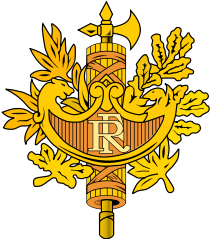French Air Force
|
||||||||||||||||||||
|
||||||||||||||||||||
The French Air Force (French: Armée de l'Air (ALA), literally Army of the Air) is the air force of the French Armed Forces. It was formed in 1909 as the Service Aéronautique. The French Air Force operates 867 aircraft, making it the 4th largest air force in terms of aircraft in NATO, after the air forces of the United States, United Kingdom and Turkey.
Contents |
History
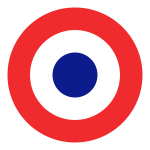
Many consider the Armée de l'Air to have been the first professional air force in the world. The French took active interest in developing the air force from 1909 and had the first WWI fighter pilots. During the interwar years, however, particularly in the 1930s, the quality fell when compared with the Luftwaffe, which crushed the French during the Battle of France.
In the post–WWII era, the French made a successful effort to develop a home grown aircraft industry. Dassault Aviation led the way with delta-wing designs, which formed the basis for the Mirage series of jet fighters. The Mirage demonstrated its abilities in the Six-Day War and the Gulf War, becoming one of the most popular and well-sold aircraft in the history of military aviation along the way.
Currently, the French Air Force is expanding and replacing. The French are awaiting the A400M military transport aircraft, which is still in developmental stages, and the integration of the new Rafale multi-role jet fighter, whose first squadron of 20 aircraft became operational in 2006 at Saint-Dizier.
After an absence lasting several decades, the French President Nicolas Sarkozy confirmed that France will rejoin the NATO integrated command[1].
Status
The ALA is organised into three levels:
Central Command
The President of France, Nicolas Sarkozy, is Chief of the armed forces, responsible for the overall defence policy. The Prime Minister is responsible for national defence and the Minister of Defence is responsible for the execution of the military policy.
He is advised by the Chief of Staff of the Armies (CEMA) in regard to the use of forces and the control of military operations. The Chief of Staff-Air Force (CEMAA) determines the air force doctrines and advises the CEMA how to deploy French aerial assets. He is responsible for the preparation and logistic support of the air force. The CEMAA is assisted by the air force staff and by its subordinate services. Finally, the CEMAA is assisted by the inspection of the air force (IAA) and by the air force health service inspection (ISSAA).
Greater operational and organic commands
In the ALA the responsibilities are separated in two main types of commands: operational commands (direct responsible for force deployment) and organic commands (in charge of conditioning and logistic support). These commands are subject to change before 2010 (see Future).
- CFAS—Strategic Air Command
All the air forces nuclear assets are placed in this command which is responsible for the operational condition and the eventual deployment of these weapons. The CFAS is one of the two pillars of the French nuclear deterrent. CFAS has 3 squadrons of dual capable Mirage 2000N fighter/bombers capable of carrying the nuclear Air-Sol Moyenne Portée stand-off missile and a squadron of C-135FR in-flight refuelling tankers at its disposal to carry out their missions. The commanding CFAS general is responsible for the execution of the mission.
- CDAOA—Air Defence and Air Operations Command
This overall command is responsible for all air operations in peacetime serving the public, for the defence of the French airspace and for all offensive and defensive air operations at war.
- CFA—Joint Air Command
A new command which has been inaugurated in 2006. It is responsible to ensure and to maintain the operational condition of all branches of the air force now and for the future. At present day the CFA consists of
- 16 fighter squadrons and 25 air defence squadrons
- 1 electronic warfare squadron
- simulator and instruction centres
On its airbases in Europe and abroad the CFA has 16m000 personnel, 279 fighter aircraft, 122 transport aircraft and 85 helicopters.
- CASSIC—Air Surveillance, Information and Communication Systems Command
This command has already been dissolved and the 8100 personnel, working in the former CASSIC have been transferred to the other existing air force commands and to the DIRISI, the interim joint defence communication and intelligence organisation.
CDAOA, based in Paris and Lyon, plans and executes all air operations. ex-CASSIC personnel are embedded here to develop exercises and operations abroad.
CFA prepares the forces. Since 2007, 38% ex-CASSIC personnel rejoined the airspace control brigade which also controls all ground-air defence units.
CSFA, based in Bordeaux, guards the technical and logistical assets. Since 2006 it has taken over many ex-CASSIC projects.
- CEAA—Air Force Training Command
Responsible for training all new air force personnel as well as on the technical and on the job training of the other air force personnel, as well as the officers and NCO training. CEAA is also responsible for all schools and training facilities.
- CFPSAA—Operational Support Command
This command is responsible for the operational readiness and the deployment of all base protecting squadrons, dog-handlers, fire brigades, paratroopers and NBC and decontamination personnel. In 2007, the CFPSAA has been renamed BAFSI (Brigade Aérienne des Forces de Sécurité et d'Intervention).
Airbase Command
The air base command levels are the combat assets of the ALA. An airbase commander has authority over all units stationed on his base. Depending on the units tasks this means that he is responsible for approximately 600 to 2500 personnel.
Flying activity in France is carried out by a network of bases, platforms and French air defence radar systems. It is supported by bases, which are supervised and maintained by staff, centres of operations, warehouses, workshops, and schools.
Both in France and abroad, bases have almost similar infrastructure to provide standardised support. This operational mode allows fast and easy creation of air bases outside of France.
Overseas, fighters, transport aircraft and helicopters allow quick response to any request for assistance that falls within international agreements. On average, a base platform, made up of about 1500 personnel (nearly 3500 people including family), provides a yearly economic boost to its area of about 60 million euros. Consequently, determining the sites for air bases constitutes a major part of regional planning.
Bases
Northern region
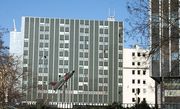
- BA 102 Dijon airbase. Air defence squadrons equipped with Mirage 2000-5.
- BA 103 Cambrai airbase. Units mainly equipped with Mirage 2000 RDI interceptors.
- BA 105 Évreux airbase. Command, operational and logistic support.
- BA 107 Villacoublay airbase. Helicopter and heavy air transport units.
- BA 110 Creil airbase. Heavy air transport units with Casa CN-235/100 for short distance and with Airbus A310-300.
- BA 112 Reims airbase. Tactical recce sqn with Mirage F1 CR.
- BA 113 Saint-Dizier airbase. Transition sqn for the new Dassault Rafale C.
- BA 116 Luxeuil airbase. CFA nuclear strike stockpile. Strike sqns equipped with Mirage 2000N.
- BA 117 Paris airbase. Central command.
- BA 123 Orléans airbase. Former CFAP and CASSIC command location. CFPSAA operational command.
- BA 128 Metz airbase. Location of the new CFA command, mixed air transport sqn.
- BA 132 Colmar-Meyenheim. Tactical squadrons equipped with Mirage F1-CT
- BA 133 Nancy Ochey airbase. Fighter squadrons Mirage 2000D, SAM sqns.
- BA 217 Brétigny. Personnel officer/nco selection and logistic units.
- BA 279 Châteaudun airbase. Airplane storage base.
- BA 702 Avord airbase. CFAS nuclear strike stockpile. AWACS Boeing E-3 Sentry unit. Inflight refueling KC-135 unit
- BA 705 Tours airbase. Fighter pilot training school.
- BA 901 Drachenbronn. Air defence radar command reporting centre.
- BA 921 Taverny. Strategic Air Command (CFAS)
- DA 273 Romorantin air detachment. Logistic unit.
- DA 922 Doullens air detachment. Disbanded command reporting centre.
Southern Region
- BA 101 Toulouse airbase. Instruction air transport unit Transall C-160 NG and Puma SA 330.
- BA 106 Mérignac airbase. Transport support base for the air staff.
- BA 115 Orange airbase. Air defence squadrons Mirage 2000D and transition sqn Mirage 2000B.
- BA 118 Mont de Marsan airbase. Home of CEAM, the Air Force military experience centre, Air defence radar command reporting centre, instruction centre for air defence control.
- BA 120 Cazaux airbase, situated South-west of the port city of Bordeaux. Air force airplane stockpile.
- BA 125 Istres airbase. CFAS nuclear strike stockpile. Strike squadron equipped with Mirage 2000N. Transall C-160 G strategic communication flight. Inflight refueling unit with C-135RF. CEAM, the Air Force military experience centre.
- BA 126 Solenzara airbase. Fighter gunnery range. SAR unit.
- BA 278 Ambérieu airbase. Logistic support base.
- BA 701 Salon de Provence. Officer instruction school. Enlisted instruction school.
- BA 709 Cognac airbase. Basic flight training school.
- BA 721 Rochefort-Saint-Agnant. NCO school.
- BA 942 Lyon Mont-Verdun. Air defence radar command reporting centre. CNOA location. National Air Operations Command.
- BA 943 Nice Roquebrune. Air defence radar command reporting centre.
- DA 204 Mérignac. Logistic detachment.
- EETAA 722 Saintes. Air force electronic and technical instruction.
- EPA 749 Grenoble. Air force child support school
Overseas
- BA 160 Dakar Ouakam, Africa. Mixed units.
- BA 181 Reunion Island. Mixed units.
- BA 188 Djibouti, Africa. Mixed units.
- Air elements Libreville and N’djamena. Helicopter units.
- BA 190 French Polynesia. Mixed unit.
- BA 365 Martinique. Mixed unit.
- BA 367 Guyana, South America. Mixed units.
- BA 376 New Caledonia, Pacific Air defence radar command BA 376 New Caledonia, Air defence squadrons Mirage 2000D and transition sqn Mirage 2000B, training facility
- BA 104 Abu Dhabi
Aircraft inventory
The French Air Force operates a fleet of 867 active aircraft. This includes fighters, transport aircraft, passenger transport and helicopters. 150 comprise the air mobility force (CFAP) and include aircraft such as C-160 and the C-130 Hercules. The CFAP also includes 80 helicopters like the Super Puma and the Ecureuil. 306 combat aircraft are incorporated into 19 squadrons. The Air 2010 concept allows for 300 fighters, mainly composed of the new generation multirole combat airplane Rafale.
| Aircraft | Origin | Type | Versions | In service[2] | Notes | |
|---|---|---|---|---|---|---|
| Combat aircraft | ||||||
| Dassault Mirage 2000 | Fighter Aircraft
Attack Aircraft Trainer Aircraft |
5F/C
D B |
185[3] | 34x Mirage 2000-5F, 52x Mirage 2000C
80x Mirage 2000D 21x Mirage 2000B, |
||
| Dassault Mirage F1 | Trainer Aircraft
Reconnaissance Attack Aircraft |
F1B
FCR/FCT |
65[4] | 7x Mirage F1B
48x Mirage F1CR, 10x Mirage F1CT |
||
| Dassault Rafale | Trainer Aircraft
Multirole Fighter |
B
C |
56[5] | 38x Rafale B
18x Rafale C |
||
| Total Aircraft | 306 | |||||
| Trainers | ||||||
| Dassault-Breguet/Dornier Alpha Jet | Trainer Aircraft (Advanced) | Alpha Jet E | 140 | |||
| Embraer EMB 121 Xingu | Trainer Aircraft | EMB 121 | 30 | |||
| Jodel D-140 | Trainer Aircraft | 18 | ||||
| Socata TB | Trainer Aircraft | TB 30 Epsilon | 92 | |||
| Walter Extra 300 | Trainer Aircraft (Aerobatic) | Extra 300SC | 3 | |||
| Total Aircraft | 283 | |||||
| Transports | ||||||
| Dassault Falcon 50 | VIP Transport | Falcon 50 | 4 | |||
| Dassault Falcon 900 | VIP Transport | Falcon 900 | 2 | |||
| Dassault Falcon 7X | VIP Transport | Falcon 7X | 1 | |||
| Socata TBM | VIP Transport | TBM 700 | 16 | |||
| Airbus A319 | VIP Transport | A319-115 CJ | 2 | |||
| Airbus A330 | VIP Transport | A330-223 | 1 | |||
| Airbus A340 | Strategic Transport | A340-211 | 2 | |||
| Airbus A310 | Strategic Transport | A310-304 | 3 | |||
| Lockheed C-130 Hercules | Tactical Transport | C-130H/C-130H-30 | 14 | |||
| CASA CN-235 | Tactical Transport | CN-235-200/CN-235-200M | 19 | |||
| Transall C-160 | Tactical Transport | C-160R | 51 | |||
| Total Aircraft | 115 | |||||
| Transport/Search and Rescue Helicopter | ||||||
| de Havilland Canada DHC-6 Twin Otter | Utility transport | DHC-6 | 5 | |||
| Eurocopter AS 532 Cougar | Transport | AS 332L | 3 | |||
| Eurocopter AS 555 Fennec | Utility | AS 555AN | 42 | |||
| Aérospatiale SA 330 Puma | Transport helicopter | SA 330 | 29 | |||
| Total Aircraft | 79 | |||||
| Maritime Patrol/Reconnaissance/Tanker | ||||||
| Boeing KC-135 Stratotanker | Refuelling | C-135FR | 14 | 1985 | ||
| Boeing E-3 Sentry | Airborne early warning | E-3F | 4 | 1991 | ||
| Transall C-160 | ELINT | C-160G Gabriel | 2 | |||
| Total Aircraft | 20 | |||||
| Nuclear strike | ||||||
| Mirage 2000N | Nuclear strike | Mirage 2000/N | 64[6] | 64x Mirage 2000N | ||
| Total Aircraft | 64 | |||||
| Total Air Craft in service | ||||||
| Total Aircraft | 867 | |||||
Ranks
| Flag officers | |||||||||
|
|||||||||
| Officers | ||||||||||||
|
||||||||||||
| Student | ||||||||||
|
||||||||||
| Non-commissioned officers | |||||||||
|
|||||||||
| Enlisted personnel | |||||||||
|
|||||||||
Future
Like most modern defence organisations the French air force is reorganising its commands, units and assets. This project to streamline the forces is called Air 2010, which is the year of the deadline for all transitions. The main targets of this project are to simplify the command structure, to regroup all military and civil air force functions and to rationalise and optimise all air force units. The solution to reach these aims seems to be changing the organisation into five major commands, instead of the former 13, and to disband several commands and units.
- CDAOA (air defence and air operations command)
- CFA (air force command)
- CSFA (logistic command)
- DRHAA (human resource direction)
- SAGF (administration and finance service)
Gallery
Fighter aircraft
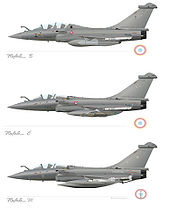 Rafale B/C |
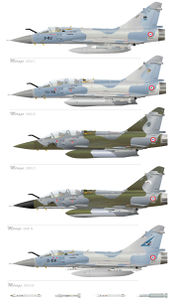 Mirage 2000 C/B/D/N/5F |
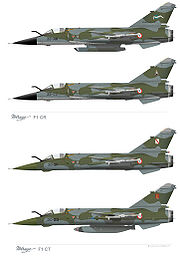 Mirage F1 CR & CT |
Transport aircraft
 Transall C160NG escardon Anjou |
 Hercules C130H & C130H30 escadron Franche Comté |
 Casa Cn 235-200 escadron vercors |
 Airbus A340 escadron Esterel |
 Airbus A310 escadron Esterel |
 Airbus A319 ETEC 65 |
 Dassault Falcon50 ETEC 65 |
 Dassault Falcon 900 ETEC 65 |
 C135FR GRV 093 Bretagne |
Trainers
 Alpha Jet E.A.C |
 Alpha Jet Patrouille de France |
 Embraer Tucano E.P.N.A.A |
 Socata Epsilon TB30 E.P.E.A.A |
 Embraer Xingu E.A.T |
See also
- List of French Air Force aircraft squadrons
Notes
- ↑ that France will rejoin NATO integrated command
- ↑ http://www.milaviapress.com/orbat/france/index.php
- ↑ http://www.milaviapress.com/orbat/france/index.php
- ↑ http://www.milaviapress.com/orbat/france/index.php
- ↑ http://www.milaviapress.com/orbat/france/index.php
- ↑ http://www.milaviapress.com/orbat/france/index.php
External links
- (French) Official website
- (English) Official website
- (French) List of air bases, appendix of the budget bill for 2006, French Senate
|
||||||||||||||
|
|||||||||||

